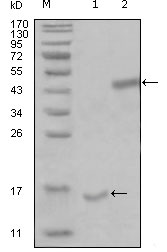PARL Monoclonal Antibody
- Catalog No.:YM0505
- Applications:WB;ELISA
- Reactivity:Human
- Target:
- PARL
- Gene Name:
- PARL
- Protein Name:
- Presenilins-associated rhomboid-like protein mitochondrial
- Human Gene Id:
- 55486
- Human Swiss Prot No:
- Q9H300
- Mouse Swiss Prot No:
- Q5XJY4
- Immunogen:
- Purified recombinant fragment of PARL (aa112-167) expressed in E. Coli.
- Specificity:
- PARL Monoclonal Antibody detects endogenous levels of PARL protein.
- Formulation:
- Liquid in PBS containing 50% glycerol, 0.5% BSA and 0.02% sodium azide.
- Source:
- Monoclonal, Mouse
- Dilution:
- WB 1:500 - 1:2000. ELISA: 1:10000. Not yet tested in other applications.
- Purification:
- Affinity purification
- Storage Stability:
- -15°C to -25°C/1 year(Do not lower than -25°C)
- Other Name:
- PARL;PSARL;Presenilins-associated rhomboid-like protein; mitochondrial;Mitochondrial intramembrane cleaving protease PARL
- Molecular Weight(Da):
- 42kD
- References:
- 1. J Alzheimers Dis. 2001 Apr;3(2):181-190.
2. Proc Natl Acad Sci U S A. 2002 Dec 24;99(26):16899-903.
3. Nature. 2003 May 29;423(6939):537-41.
- Background:
- This gene encodes a member of the rhomboid family of intramembrane serine proteases that is localized to the inner mitochondrial membrane. The encoded protein regulates mitochondrial remodeling and apoptosis through regulated substrate proteolysis. Proteolytic processing of the encoded protein results in the release of a small peptide, P-beta, which may transit to the nucleus. Mutations in this gene may be associated with Parkinson's disease. [provided by RefSeq, May 2016],
- Function:
- catalytic activity:Cleaves type-1 transmembrane domains using a catalytic dyad composed of serine and histidine that are contributed by different transmembrane domains.,function:Required for the control of apoptosis during postnatal growth. Essential for proteolytic processing of an antiapoptotic form of OPA1 which prevents the release of mitochondrial cytochrome c in response to intrinsic apoptoptic signals (By similarity). Promotes changes in mitochondria morphology regulated by phosphorylation of P-beta domain.,PTM:P-beta is proteolytically processed (beta-cleavage) in a PARL-dependent manner. The cleavage is inhibited when residues Ser-65, Thr-69 and Ser-70 are all phosphorylated.,similarity:Belongs to the peptidase S54 family.,subcellular location:Translocated into the nucleus by an unknown mechanism.,subunit:Interacts with PSEN1 and PSEN2. Binds OPA1.,
- Subcellular Location:
- Mitochondrion inner membrane ; Multi-pass membrane protein .; [P-beta]: Nucleus . Translocated into the nucleus by an unknown mechanism (PubMed:17116872). .
- Expression:
- Fetal liver,Lung,
- June 19-2018
- WESTERN IMMUNOBLOTTING PROTOCOL
- June 19-2018
- IMMUNOHISTOCHEMISTRY-PARAFFIN PROTOCOL
- June 19-2018
- IMMUNOFLUORESCENCE PROTOCOL
- September 08-2020
- FLOW-CYTOMEYRT-PROTOCOL
- May 20-2022
- Cell-Based ELISA│解您多样本WB检测之困扰
- July 13-2018
- CELL-BASED-ELISA-PROTOCOL-FOR-ACETYL-PROTEIN
- July 13-2018
- CELL-BASED-ELISA-PROTOCOL-FOR-PHOSPHO-PROTEIN
- July 13-2018
- Antibody-FAQs
- Products Images

- Western Blot analysis using PARL Monoclonal Antibody against truncated Trx-PARL recombinant protein (1) and truncated MBP-PARL(aa112-167) recombinant protein (2).



